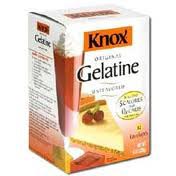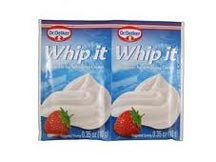How to NEVER Run Out of Whipping Cream!
By Patty Liston
 Whipping cream is versatile and yummy. It's always good to have some on hand, so be sure to stock up when it goes on sale. And now is the time of year it starts to go on sale - as soon as strawberries emerge on the produce market, you'll find whipping cream at attractive prices.
Whipping cream is versatile and yummy. It's always good to have some on hand, so be sure to stock up when it goes on sale. And now is the time of year it starts to go on sale - as soon as strawberries emerge on the produce market, you'll find whipping cream at attractive prices.
But how can I stock up on something that won't keep for very long, you wonder? Hah! Freeze it, that's how. Here's what you do:
1. Pour it into all your ice cube trays (borrow trays from your neighbor if you need to).
2. Freeze the cream until it's solid.
3. Pop cubes into freezer bags. (One cube is approximately 3 tablespoons of thawed cream.)
4. When needing whipped cream, thaw amount of cubes needed (in refrigerator), then whip as usual.
 These cream cubes are also very handy when wanting a blender fruit smoothie with a little decadence (what other kind is there?). Just add them in with other ingredients - the finished product is almost like ice cream. This is good enough to serve as a dessert, by the way.
These cream cubes are also very handy when wanting a blender fruit smoothie with a little decadence (what other kind is there?). Just add them in with other ingredients - the finished product is almost like ice cream. This is good enough to serve as a dessert, by the way.
 I love whipped cream so much (must be the Scandinavian in me) that I even have a chapter in my Cook'n Recipe Organizer (version 10) titled "Whipping Cream Recipes." I love how quickly I can access what I'm looking for when that whipped cream craving strikes!
I love whipped cream so much (must be the Scandinavian in me) that I even have a chapter in my Cook'n Recipe Organizer (version 10) titled "Whipping Cream Recipes." I love how quickly I can access what I'm looking for when that whipped cream craving strikes!
Now let's talk health: Whipped cream is made from cream, which is the high-fat layer of milk, therefore, it's not the best product for people watching their fat intake. The good news is that when you're eating whipped cream, most of what you are eating is air. One or two tablespoons of whipped cream typically has less than 30 calories, so a dollop on your dessert won't make a huge difference. In other words, TEMPERANCE, or moderation in all things is the motto here.
Most people don't eat whipped cream by itself (oh yeah?), so why add it to food? It contributes three beneficial characteristics. First, the whipped cream brings in a cool temperature. With a hot food or drink, this creates a nice contrast. Secondly, whipped cream can add a sweet milkiness to a food or drink. The flavor works well to contrast other sweet items, since the sweetness in whipped cream is light. Lastly, whipped cream adds texture to a food or drink. It is light, smooth, and fluffy, so it works well with heavier foods.
 And here's some sort-of -encouraging news for those that are lactose intolerant: Cream has LESS lactose than milk and evaporated milk. According to the research on ourworld.compuserve.com, whipping cream is 2.9% lactose, while whole milk is 4.8% and skim milk is 5.2%.
And here's some sort-of -encouraging news for those that are lactose intolerant: Cream has LESS lactose than milk and evaporated milk. According to the research on ourworld.compuserve.com, whipping cream is 2.9% lactose, while whole milk is 4.8% and skim milk is 5.2%.
Evaporated milk is a big 10.3%! So here again, with some temperance and moderation, even the lactose intolerant may be able to enjoy whipped cream. It's worth a try in my book. To conclude, how about information on stabilizing whipped cream? Stabilizing whipped cream gives it a firmer texture and allows it to be used as piping for a decorative border on a cake, prevents it from weeping, and stops it from deflating when mixed with juicy ingredients, such as strawberries and raspberries. Here's how to stabilize whipped cream:
 1. Soak 1/2 teaspoon of plain gelatin in 1 tablespoon of cold water for 5 minutes.
1. Soak 1/2 teaspoon of plain gelatin in 1 tablespoon of cold water for 5 minutes.
2. Place the gelatin and cold water in a heat resistant container and set in a small pan of very hot water just until the gelatin is dissolved. If heating on a stove, do not allow the gelatin to boil.
3. After gelatin has dissolved, set it aside to cool. Allow it to cool to about body temperature. Note: if the gelatin is too hot it will deflate the whipped cream when it is added and if it is allowed to cool too much it will thicken too much and not incorporate into the cream.
4. Follow instructions above for whipping the cream. Add the gelatin after the sugar and flavoring has been whipped in but before the cream forms soft peaks.
5. Once the gelatin is incorporated in the whipped cream, beat until cream forms soft peaks, and then stop beating with the electric mixer. Finish whipping with a wire balloon whisk to bring the cream to the desired consistency.
6. If the whipped cream is to be spread on a cake or dessert, use immediately because it will set quickly and become difficult to spread.
Using gelatin to stabilize whipping cream can be a problem if not done properly. But there are other methods that can be used to help stabilize the whipped cream:
 • Add 2 teaspoons of nonfat dry milk to one cup of cream before whipping.
• Add 2 teaspoons of nonfat dry milk to one cup of cream before whipping.
• Add 1 teaspoon of light corn syrup to one cup of cream before whipping.
• Use powdered sugar instead of granulated sugar when sweetening. Powdered sugar generally contains cornstarch which helps stabilize the whipped cream.
• Incorporate a melted marshmallow into the whipped cream towards the end of whipping.
• Use a commercial type stabilizer that binds the liquid parts of the cream, helping to stabilize it. One of the types available is Dr. Oetker's Whip It.

